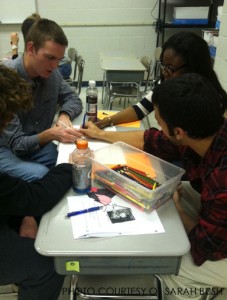

Melancholy groans echo throughout the classroom. Feet shuffle, only to be masked by the occasional clang of a desk scraping along the floor. Uncomfortable students force out restrained introductions as they sit awkwardly in reserve. These omens can mean but one thing: group project time.
Now, in theory, a group project should be a relatively efficient, time-saving assignment that helps to boost student averages. Mrs. Wilkerson, English teacher, described the way in which group projects are designed.
“Students should get together, distribute the workload evenly amongst themselves and have each group member complete his/her own portion based on the ideas of the group,” said Wilkerson. “Then, in the end, students meet up, connect their parts and prepare to present to the class.”
On paper, an ideal system; in real life, an abandoned plan.
Unfortunately, there are two types of people in group projects: the leaders and the members. Leaders confidently take charge of their crews, assign roles and take center stage when it comes time to present.
Jessica Stout, junior and self-described group leader, said,” Whenever I’m assigned to a group, it seems like the other kids are just waiting for someone to take control. They know that I care about my grades and will do what it takes to do well, so they slack off and leave me with everything. It can be very frustrating.”
“The other kids” that Stout mentioned are better known as the members. Members have a tendency to keep to themselves, do the minimal amount of work possible, and show up on presentation day to read their required one PowerPoint slide.
Natalie Williams, junior, spoke about her experiences with group projects in the past. “Most groups have at least one slacker, if not more. I’ve even seen whole groups of slackers, which is the worst, because nobody is willing to be a leader,” said Williams.
Group activities don’t only fall short of their purposes in the classroom, but also in the workplace and at times in our childhoods. Playing outside growing up, kids would converge in groups to play neighborhood games of baseball and hide-and-seek. However, those games never take place unless one child is willing to go door to door chasing his friends, only to struggle making teams and take the blame if something goes wrong.
The same goes for groups of employees. When workers team up to complete a presentation or an assignment, often times one poor staff-member ends up pulling an all-nighter because someone else “forgot” their part. Throughout our lives, we are forced to work together, but for many reasons, hardly ever do our groups live up to expectations.
Wilkerson acknowledged that other problems exist besides just the division of leaders and members. Said Wilkerson, “Some groups have bad attitudes and some groups have no incentive. Some have conflicting opinions and some are socially unable to work together. There’s a whole wave of problems. It’s a shame because group work has so much potential.”
And it does. What Wilkerson means is that group projects serve as a way for students to learn to collaborate like they will later on in the business world. Both Stout and Williams criticized the group project system, but neither was ready to condemn it, primarily because of the possible benefits.
Said Williams, “Groups can work and every once in a while they do. People bounce ideas off each other, they utilize each person’s particular strengths, and share ideas that grow within the group. It’s much easier when everything and everyone comes together like they’re supposed to.”
Stout agreed. “As you get older, you see that more kids care about their grades and are willing to contribute, which is refreshing. People want to help themselves and each other succeed, so they work together, they share ideas, they offer their opinions. That’s the way groups are supposed to work.”